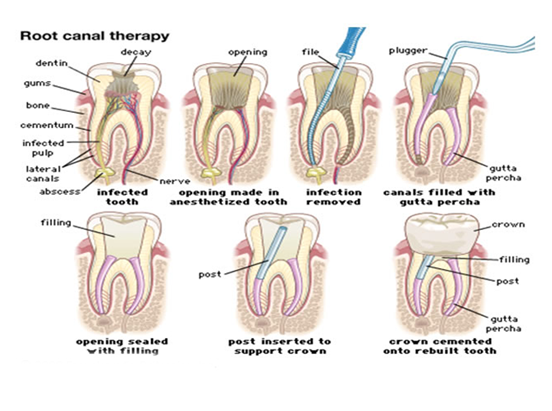" The man with a toothache thinks everyone happy whose teeth are sound. "
Endodontics
Expert deals with decay of teech whihc extents into the pulp chamber. The most common procedure done in endodontics is root-canal therapy, which involves the removal of diseased pulp tissue. The aim of treatment is to remove infection caused by bacteria from inside the tooth. We use anesthesia to make the procedure pain-free. An opening is made on the top of the tooth. Then the pulp chamber and root canals are cleaned and shaped for filling and sealing. The permanent filling is followed by new crown. We use Lasers for sterilization of root canals
Root Canal With Laser
The Procedure
The Root Canal procedure usually requires one to two visits, depending on the number of teeth and severity affected. However, this does not include follow up visits which are often necessary.
Step 1:
The endodontist will examine the tooth and x-rays before numbing the area around the affected tooth. A small protective sheet called a "dental dam," is placed over the area. This will isolate the tooth and keep it clean and free of saliva throughout the procedure.
Step 2:
They will then drill through to the pulp area, either through the top or the back of the tooth. Very small instruments and an antiseptic solution will be used to clean the pulp and root canals and a space is shaped for a filling.
Step 3:
When the space has been cleaned and shaped, the endodontist will fill the root canal with a biocompatible material. This is usually a flexible plastic material called "gutta-percha" ensuring that the root canals are completely sealed. Normally, a temporary filling will be inserted to close the opening. The temporary filling will be removed by your dentist before the tooth is restored.
Step 4:
After your final visit to your endodontist, you must return to your dentist for the restoration work. If there is no sign of any infection a crown or permanent filling will be inserted within a month of the root canal procedure.
Step 5:
If the tooth is too weak to hold the restoration in place, your dentist or endodontist may place a post inside the tooth. Ask your endodontist for more details about the specific restoration planned for your tooth.
Advantages:
- Pain is always associated with root canals, but the truth is that there should be little or no pain during the procedure.
- We do not carry out this procedure for aesthetic reasons, for the good of your health.
- Any infection will only get worse with time, if left untreated.
- The root canal procedure has a success rate of over 92 percent.
- The greatest advantage is that the tooth will not need to be extracted in the future.
Disadvantages:
- Occasionally, infected tissue is pushed through the ends of the root infecting the gum. This can be treated easily, but there will be some pain until the infection is cleared up.
- Canals are irregularly shaped, and if the canal is not accurately measured then it won't be cleaned or filled properly. This will cause the pulp to become infected again and a second procedure will be necessary.
Reasons for Root Canal "Retreatment"
- Incomplete Cleaning and Sealing.
- Retained microorganisms (bacteria) in the root canal.
- Complicated canal anatomy went undetected in the first procedure.
- Narrow or curved canals were not treated during the initial procedure.
- The placement of the crown or other restoration was delayed following the endodontic treatment.
- New decay can expose the root canal filling material to bacteria, causing a new infection in the tooth.
- A loose, cracked or broken crown or filling can expose the tooth to new infection.
- Inoperable canals because of calcification or unusual anatomy.
- Sometimes tissues fail to heal for unknown reasons.
- A tooth sustains a fracture
Once retreatment has been selected as a solution to your problem, the doctors will reopen your tooth to gain access to the root canal filling material. This restorative material will be removed to enable access to the root canal. The doctors will now clean your canals and carefully examine the inside of the problematic tooth. Once cleaned, the doctors will fill and seal the canals and place a temporary filling in the tooth. At this point, you will need to return to your dentist as soon as possible in order to have a new crown or restoration placed on the tooth to restore full functionality.
Root Canal Surgery
To understand Endodontic surgery, it helps first to know something about the non surgical endodontic procedure, or "root canal". Root canal treatment is necessary when the soft inner tissue, or "pulp", of the tooth becomes inflamed or infected. This may happen as a result of deep decay, repeated dental procedures on the tooth, or an injury to the tooth. Root canal (endodontic) treatment removes the damaged pulp. Then the tooth's canals are cleaned and filled to help preserve the tooth.
In a few cases, however, root canal (non surgical endodontic) treatment alone cannot save the tooth. In such a case, your dentist or endodontist may recommend surgery. Endodontic surgery can help save your tooth in a variety of situations. Endodontic surgery usually takes less than 30 minutes and is successful most of the time.
Treatment depends on the cause of failure and still another chance on maintaining the tooth. The most common Endodontic surgery is root end resection with root end filing also known as 'Apico' or Apicoectomy and retrofill.







